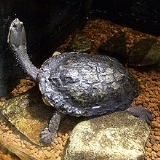
Argentine Snake-necked Turtle
Encyclopedia
The Argentine snake-necked turtle, also known as the South American snake-necked turtle (Hydromedusa tectifera) is a species of turtle, known for the long neck which gave it its name. Despite appearances, the Argentine snake-necked turtle is actually more closely related to the Mata mata
(Chelus fimbriatus) than to the Australian snake-necked turtles in the genus Chelodina
. It is found in northern Argentina
, Uruguay
, Paraguay
, and southern Brazil
. Not much is known about them, as they have not been extensively researched. They are a popular pet in the exotic pet trade.
is strongly keeled, and can also be distinguished by black and yellowish markings along its head and neck. Generally, the females are larger than the males, who often have larger tails.
s, aquatic insects, fish
, and amphibian
s. It attacks its prey with a combination of the Matamata's vacuum suction and the stabbing neck motions of other snake-necked turtles. Courtship and mating has not been extensively observed in this species, although it is known that nesting occurs in the spring at the riverbanks. The eggs
are 34x22 mm long, white, and brittle-shelled. Hatchlings are about 34 mm long, and have more wrinkled carapaces than adults.
Mata mata
The mata mata or matamata is a freshwater turtle found in South America, primarily in the Amazon and Orinoco basins.-Taxonomy:...
(Chelus fimbriatus) than to the Australian snake-necked turtles in the genus Chelodina
Chelodina
This large and diverse genus of long-necked Chelid turtles has had a complicated nomenclatural history. Although in the past the following have been considered separate genera and prior to that all the same, they are now considered sub-genera of the one genus....
. It is found in northern Argentina
Argentina
Argentina , officially the Argentine Republic , is the second largest country in South America by land area, after Brazil. It is constituted as a federation of 23 provinces and an autonomous city, Buenos Aires...
, Uruguay
Uruguay
Uruguay ,officially the Oriental Republic of Uruguay,sometimes the Eastern Republic of Uruguay; ) is a country in the southeastern part of South America. It is home to some 3.5 million people, of whom 1.8 million live in the capital Montevideo and its metropolitan area...
, Paraguay
Paraguay
Paraguay , officially the Republic of Paraguay , is a landlocked country in South America. It is bordered by Argentina to the south and southwest, Brazil to the east and northeast, and Bolivia to the northwest. Paraguay lies on both banks of the Paraguay River, which runs through the center of the...
, and southern Brazil
Brazil
Brazil , officially the Federative Republic of Brazil , is the largest country in South America. It is the world's fifth largest country, both by geographical area and by population with over 192 million people...
. Not much is known about them, as they have not been extensively researched. They are a popular pet in the exotic pet trade.
Anatomy and morphology
The turtle can reach up to 28 centimeters (11 inches) in length. Its carapaceCarapace
A carapace is a dorsal section of the exoskeleton or shell in a number of animal groups, including arthropods such as crustaceans and arachnids, as well as vertebrates such as turtles and tortoises. In turtles and tortoises, the underside is called the plastron.-Crustaceans:In crustaceans, the...
is strongly keeled, and can also be distinguished by black and yellowish markings along its head and neck. Generally, the females are larger than the males, who often have larger tails.
Natural history
Argentine snake-necked turtles live in slow-moving ponds, rivers, streams, and marshes, preferably with aquatic vegetation. In coastal areas, they will enter brackish water, and they may hibernate in colder areas of their distribution. The turtles are carnivorous and eat snailSnail
Snail is a common name applied to most of the members of the molluscan class Gastropoda that have coiled shells in the adult stage. When the word is used in its most general sense, it includes sea snails, land snails and freshwater snails. The word snail without any qualifier is however more often...
s, aquatic insects, fish
Fish
Fish are a paraphyletic group of organisms that consist of all gill-bearing aquatic vertebrate animals that lack limbs with digits. Included in this definition are the living hagfish, lampreys, and cartilaginous and bony fish, as well as various extinct related groups...
, and amphibian
Amphibian
Amphibians , are a class of vertebrate animals including animals such as toads, frogs, caecilians, and salamanders. They are characterized as non-amniote ectothermic tetrapods...
s. It attacks its prey with a combination of the Matamata's vacuum suction and the stabbing neck motions of other snake-necked turtles. Courtship and mating has not been extensively observed in this species, although it is known that nesting occurs in the spring at the riverbanks. The eggs
Egg (biology)
An egg is an organic vessel in which an embryo first begins to develop. In most birds, reptiles, insects, molluscs, fish, and monotremes, an egg is the zygote, resulting from fertilization of the ovum, which is expelled from the body and permitted to develop outside the body until the developing...
are 34x22 mm long, white, and brittle-shelled. Hatchlings are about 34 mm long, and have more wrinkled carapaces than adults.

